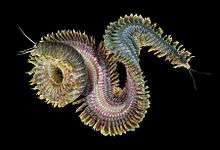Alitta virens
| Alitta virens | |
|---|---|
 | |
| Scientific classification | |
| Kingdom: | Animalia |
| Phylum: | Annelida |
| Class: | Polychaeta |
| Order: | Aciculata |
| Family: | Nereididae |
| Genus: | Alitta |
| Species: | A. virens |
| Binomial name | |
| Alitta virens (M. Sars, 1835) [1] | |
| Synonyms[1] | |
| |
Alitta virens (common names include sandworm and king ragworm; older scientific names including Nereis virens are still frequently used) is an annelid worm that burrows in wet sand and mud. It is classified as a polychaete in the family Nereididae .[1]
Sandworms make up a large part of the live sea-bait industry. To fulfill the needs of this industry, some sandworms are commercially grown.[2] "Sandworming", or the harvesting of sandworms from mudflats, employs over 1,000 people in Maine. As of 2006, the population of sandworms had diminished greatly over the preceding few years due in large part to overharvesting before the worms are able to reproduce by spawning.
Sandworms eat seaweed and microorganisms. They have many distinctive traits, including
- often reaching great length, sometimes exceeding four feet
- numerous, highly vascularized parapodia along both sides of their bodies
- blue heads with two large pincer teeth which are capable of biting humans [3]
The parapodia function both as external gills (the animal's primary respiratory surfaces), and as means of locomotion (appearing much like short legs).
Gallery
References
- 1 2 3 Kristian Fauchald & Chris Glasby (2009). Kristian Fauchald, ed. "Alitta virens (M. Sars, 1835)". World Polychaeta database. World Register of Marine Species. Retrieved January 19, 2010.
* indicates a heterotypic synonym - ↑ De kweek van zagers op landbouwbedrijven in Zeeland
- ↑ "King Ragworm". BritishSeaFishing.co.uk. Retrieved 24 January 2014.
.jpg)

.jpg)
.jpg)
.jpg)
.jpg)